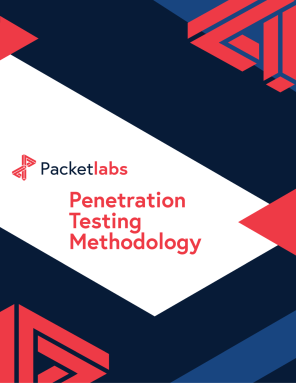IoT Penetration Testing: An Overview
- Overview
- This Guide Includes
- Who Will Benefit From This Guide
- What is IoT Penetration Testing?
- Why IoT Penetration Testing is Essential
- Packetlabs IoT Penetration Testing Methodology
- Packetlabs' IoT Security
- What Makes IoT Penetration Testing Different From Other Pentesting Types?
- Comparison: IoT Penetration Testing vs. Other Types of Penetration Testing
- Regulatory & Compliance Alignment
- Why Choose Packetlabs
- What Do IoT Pentesting Reports Include?
- Next Steps
Would you like to learn more?
Download our Pentest Sourcing Guide to learn everything you need to know to successfully plan, scope, and execute your penetration testing projects.
Overview
The global cost of cybercrime continues to grow at an alarming rate, projected to surge to nearly $23.84 trillion by 2027. As this threat landscape evolves, one of the most vulnerable and rapidly expanding attack surfaces lies in the Internet of Things (IoT).
From smart homes and connected vehicles to industrial sensors and healthcare devices, IoT systems have become deeply embedded in our everyday lives and critical infrastructure. Unfortunately, every connected device introduces potential new entry points for threat actors: making IoT security not just an IT issue, but a matter of safety, privacy, and operational continuity.
Attackers increasingly exploit IoT ecosystems to steal sensitive data, leverage devices for network infiltration, or launch ransomware and DDoS attacks that can cripple services and disrupt operations. Even a single compromised endpoint can have devastating ripple effects, from operational downtime and reputational damage to costly regulatory fines and class-action lawsuits.
In recent years, numerous high-severity IoT vulnerabilities have prompted global alerts from organizations such as the U.S. Cybersecurity organization and Infrastructure Security Agency (CISA), highlighting the urgent need for proactive and continuous IoT security testing.
The purpose of this guide is to help you understand what IoT Penetration Testing entails, how it differs from traditional security testing, and why it’s essential for protecting modern connected environments. You’ll also learn about Packetlabs’ IoT Penetration Testing methodology, what to expect from an engagement, and how our Continuous Pentesting empowers clients to remediate risks long-term.
This Guide Includes
A comprehensive overview of IoT Penetration Testing
Why IoT security is critical in today’s hyper-connected world
The phases and activities involved in an IoT penetration test
How IoT pentesting compares to other forms of security testing
How IoT testing supports regulatory compliance efforts
What to expect from a Packetlabs IoT Pentest engagement
Next steps for organizations ready to secure their IoT ecosystem
Who Will Benefit From This Guide
This guide is designed for:
CISOs, CTOs, and IT leaders responsible for connected infrastructure
Product security and engineering teams managing IoT solutions
Network and security administrators
Managed Service Providers (MSPs) and IoT platform providers
Compliance officers and cyber insurance coordinators seeking evidence-based assurance
What is IoT Penetration Testing?
IoT Penetration Testing is a comprehensive evaluation of the security posture of connected devices, communication protocols, and supporting infrastructure that make up an organization’s IoT ecosystem.
Unlike conventional network or web application testing, IoT pentesting involves assessing the device firmware, hardware interfaces, wireless protocols, APIs, mobile apps, and backend cloud components to identify vulnerabilities that could enable an attacker to compromise or control IoT devices.
The assessment delivers a complete picture of your IoT environment’s resilience, including:
Identification of exploitable vulnerabilities across device layers
Risk-based prioritization of findings
Recommendations for hardening device firmware, applications, and networks
Why IoT Penetration Testing is Essential
The IoT landscape is vast, decentralized, and constantly changing. Millions of interconnected devices often lack adequate encryption, secure authentication, or update mechanisms. As a result, threat actors exploit these weak points to:
Hijack devices for botnets or DDoS attacks
Eavesdrop on or exfiltrate sensitive information
Move laterally within enterprise networks
Manipulate operational systems or cause safety hazards
A single weak IoT node can compromise the integrity of an entire environment. Regular IoT penetration testing ensures you’re proactively identifying and closing these security gaps before attackers do.
Benefits include:
Protecting customer data and intellectual property
Reducing operational downtime
Preventing unauthorized device control or data manipulation
Supporting ISO 27001, NIST 8259, IoT Cybersecurity Improvement Act, and similar compliance frameworks
Enhancing trust and market credibility for IoT products and services
Packetlabs IoT Penetration Testing Methodology
Each engagement is tailored to the client’s architecture, device type, and risk profile.
Packetlabs’ IoT penetration tests are designed to be comprehensive, production-safe, and 100% manually executed by certified ethical hackers.
Packetlabs' IoT Security Assessments Include:
Device & Firmware Analysis
Reverse-engineering firmware to uncover hardcoded credentials, insecure configurations, and backdoors.
Reviewing update mechanisms and cryptographic integrity checks.
Network & Protocol Assessment
Examining communication channels (Wi-Fi, Bluetooth, Zigbee, MQTT, LoRa, etc.) for insecure transmissions or weak encryption.
Evaluating segmentation between IoT and IT networks.
API & Cloud Backend Testing
Assessing APIs, cloud dashboards, and web interfaces for injection, authorization, and privilege escalation flaws.
Mobile Companion Application Testing
Testing mobile applications that interact with IoT devices for insecure API calls or data storage vulnerabilities.
Hardware Interface & Physical Access Testing
Evaluating UART, JTAG, and USB interfaces for potential extraction or firmware modification risks.
Social Engineering & Human Element
Testing personnel awareness, device provisioning processes, and insider threat scenarios.
All findings are correlated to the MITRE ATT&CK for ICS/IoT framework to provide actionable, intelligence-driven remediation steps.
What Makes IoT Penetration Testing Different From Other Pentesting Types?
While traditional penetration testing focuses on servers, applications, and networks, IoT pentesting must account for the complexity of hybrid environments where hardware, firmware, and cloud systems intersect.
Key differentiators:
Device-level focus: Assessment of physical components and firmware integrity
Protocol diversity: Involves wireless, mesh, and proprietary communications rarely seen in standard IT networks
Safety and reliability: Testing must be non-disruptive to ensure continuous device operation
Embedded compliance: Addresses specific IoT standards and certification requirements
Please see the table below for a direct comparison of IoT pentesting vs. other common testing types.
Comparison: IoT Penetration Testing vs. Other Types of Penetration Testing
Category | IoT Penetration Testing | Infrastructure Penetration Testing | Application Security Testing | Cloud Penetration Testing | Wireless Penetration Testing |
Primary Focus | Security of connected devices, embedded systems, and communication protocols | Servers, networks, and internal/external infrastructure | Web and mobile applications and APIs | Cloud environments (AWS, Azure, GCP) | Wireless access points and network configurations |
Typical Assets Tested | IoT devices, sensors, gateways, firmware, APIs, mobile apps, and cloud dashboards | Routers, firewalls, servers, Active Directory, network segments | Web applications, APIs, authentication flows, business logic | Cloud services, IAM roles, configurations, containers, and cloud storage | Wi-Fi routers, access points, SSIDs, encryption schemes, and authentication |
Key Attack Vectors | Firmware manipulation, insecure protocols (MQTT, BLE, Zigbee), hardware interfaces (UART/JTAG), weak authentication | Network segmentation flaws, open ports, weak credentials, privilege escalation | Injection, XSS, authentication bypass, logic flaws | Misconfigured IAM roles, exposed storage buckets, weak keys, insecure APIs | WPA2/WPA3 attacks, rogue APs, credential harvesting, weak encryption |
Testing Layers | Hardware, firmware, network, API, mobile, and cloud | Network and system layers | Application and API layers | Cloud infrastructure, APIs, and identity | Wireless layer and connected infrastructure |
Data Sensitivity | High (often involves PII, telemetry, or control signals) | Moderate to high | High (typically customer or transactional data) | High (depends on hosted workloads) | Medium (credentials, internal access points) |
Testing Methodologies | Firmware reverse engineering, protocol fuzzing, hardware interface analysis, MITRE ATT&CK for ICS/IoT | OWASP, NIST SP 800-115, PTES | OWASP Web Security Testing Guide, OWASP ASVS | CIS Benchmarks, CSA CCM, OWASP Cloud Security | Wireless Security Assessment (802.11), OWASP |
Specialized Skills Required | Hardware analysis, embedded systems, RF testing, firmware reverse engineering | Network and system exploitation | Secure coding, web exploitation, and business logic analysis | Cloud configuration, API exploitation, IAM privilege management | Radio frequency analysis and wireless protocol exploitation |
Tools & Techniques | Burp Suite, Binwalk, Wireshark, JTAGulator, Shodan, SDR tools | Nmap, Metasploit, Nessus, Burp Suite, custom scripts | Burp Suite, OWASP ZAP, Postman, custom exploits | ScoutSuite, Pacu, CloudMapper, Burp Suite | Aircrack-ng, Kismet, Wireshark, Wifite |
Unique Challenges | Proprietary hardware and firmware, limited patching, safety-critical environments | Network segmentation and legacy systems | Complex business logic, third-party integrations | Constantly changing cloud services and shared responsibility model | Signal interference and physical proximity requirements |
Common Deliverables | Device-specific vulnerability report, firmware analysis, communication flow diagrams, exploit paths | Network vulnerability assessment with attack path analysis | Application vulnerability report with proof-of-concept exploits | Cloud configuration review and exploitation path | Wireless network report detailing rogue access, encryption flaws, and mitigations |
Best Suited For | Manufacturers, IoT solution providers, smart infrastructure operators | Enterprises, data centers, IT service providers | SaaS companies, fintech, e-commerce, healthcare | Organizations leveraging cloud platforms for production workloads | Enterprises and campuses with wireless infrastructure |
Regulatory & Compliance Alignment
IoT Penetration Testing supports compliance with:
NISTIR 8259A / 8259B (IoT Device Cybersecurity Capability Core Baseline)
IoT Cybersecurity Improvement Act of 2020 (for U.S. federal suppliers)
Regular testing demonstrates due diligence, supports procurement and cyber insurance requirements, and reduces the likelihood of costly breaches or noncompliance penalties.
Why Choose Packetlabs
Packetlabs is a trusted global leader in cybersecurity, specializing in advanced penetration testing for IoT, cloud, web, and infrastructure systems.
Why organizations choose us:
All testers hold at least the OSCP certification, with many also earning OSWE, OSEP, and GXPN credentials.
100% of testing is conducted in-house, ensuring data privacy and consistency.
Clients rate Packetlabs engagements an average of 9.5/10 in post-project satisfaction.
We deliver transparent communication, detailed remediation guidance, and post-engagement support.
Our consultative approach goes beyond identifying vulnerabilities: we partner with you to strengthen your entire IoT security ecosystem long-term..
What Do IoT Pentesting Reports Include?
Every Packetlabs IoT Penetration Test includes:
A detailed, prioritized report highlighting vulnerabilities, exploitation paths, and risk severity
Executive summary for leadership and board-level communication
Technical findings with evidence (e.g., screenshots, payload logs, and reproduction steps)
Actionable remediation roadmap aligned to business impact
Optional validation retesting post-remediation
Next Steps
If your organization designs, manages, or relies on IoT devices (from consumer products to smart industrial systems), now is the time to ensure your environment is secure.
Connect with our experts today to:
Understand your IoT risk profile
Discuss testing scope and timelines
Begin fortifying your connected ecosystem against tomorrow’s threats
Contact Us
Speak with an Account Executive
Interested in Pentesting?

Penetration Testing Methodology
Our Penetration Security Testing methodology is derived from the SANS Pentest Methodology, the MITRE ATT&CK framework, and the NIST SP800-115 to uncover security gaps.
Download Methodology
Pentest Sourcing Guide
Download our Pentest Sourcing Guide to learn everything you need to know to successfully plan, scope, and execute your penetration testing projects.
Download GuideExplore in-depth resources from our ethical hackers to assist you and your team’s cyber-related decisions.

September 13 - Blog
Why Multi-Factor Authentication is Not Enough
Knowing is half the battle, and the use and abuse of common frameworks shed insight into what defenders need to do to build defense in depth.

November 19 - Blog
The Top Cybersecurity Statistics for 2024
The top cybersecurity statistics for 2024 can help inform your organization's security strategies for 2025 and beyond. Learn more today.

October 24 - Blog
Packetlabs at SecTor 2024
Packetlabs is thrilled to have been a part of SecTor 2024. Learn more about our top takeaway's from this year's Black Hat event.







